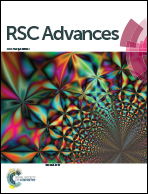Impedimetric detection of pathogenic bacteria with bacteriophages using gold nanorod deposited graphite electrodes†
Abstract
Electrochemical impedance spectroscopy (EIS) is applied for the detection of bacteria using bacteriophages as a bioprobe together with gold nanorods (GNRs). Escherichia coli – E. coli K12 was used as a model target bacteria and also for the propagation of its specific T4-phages. Gold nanorods (GNRs) were synthesized via a two-step protocol and characterized using different techniques. EIS measurements were conducted in an electrochemical cell consisting of a three electrode system. Single-use pencil graphite electrodes (PGE) were modified by the physical adsorption of GNRs to increase their interfacial conductivity and therefore sensitivity for impedimetric measurements. Therefore, interfacial charge-transfer resistance values (Rct) sharply decreased after GNRs deposition. Phages were adsorbed on these electrodes via a simple incubation protocol at room temperature, which resulted in an increase in Rct values, which was concluded to be as a result of nonconductive phage layers. These phage-carrying GNRs–PGEs were used for impedimetric detection of the target bacteria, E. coli. Significant increases at the Rct values were observed which were attributed to the insulation effects of the adsorbed bacterial layers. This increase was even more when the bacterial concentrations were higher. In the case of the non-target bacteria Staphylococcus aureus (S. aureus), conductivity noticeable decreases (due to nonspecific adsorption). However, in the case of E. coli, the Rct value increase is time dependent and reaches maximum in about 25–30 min, then decreases gradually as a result of bacterial lysis due to phage invasion on the electrode surfaces. In contrast, there were no time dependent changes with the non-target bacteria S. aureus (no infection and no lytic activity). It is concluded that the target bacteria could be detected using this very simple and inexpensive detection protocol with a minimum detection limit of 103 CFU mL−1 in approximately 100 μL bacterial suspension.


 Please wait while we load your content...
Please wait while we load your content...